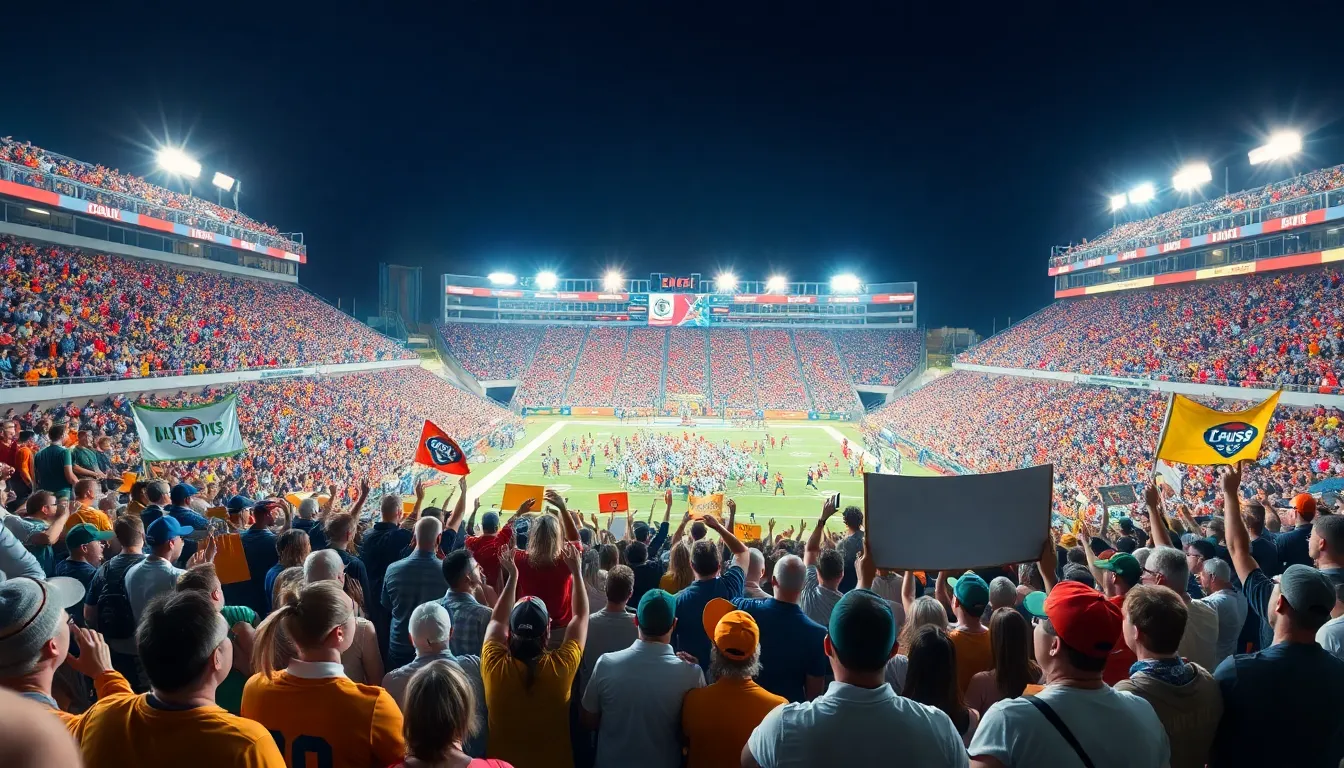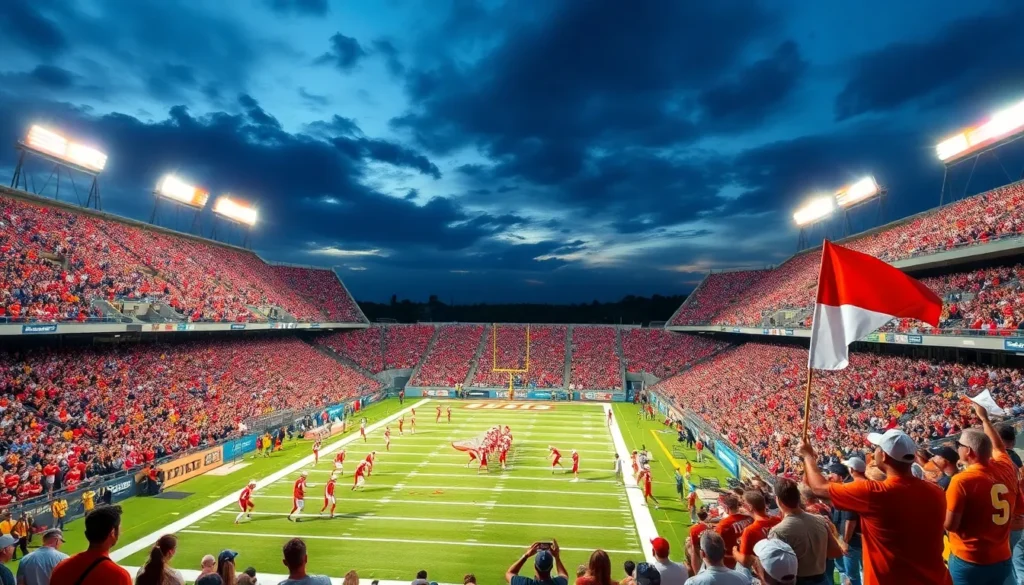Table of Contents
ToggleCollege football isn’t just a game; it’s a battleground where legends are made and dreams are crushed. Picture this: a packed stadium, a sea of rival fans, and the pressure that could make even a seasoned quarterback sweat bullets. The toughest places to play college football aren’t just about the weather or the noise; it’s about the atmosphere that turns every snap into a high-stakes showdown.
Overview of College Football Toughness
College football represents a unique blend of skill, strategy, and pressure. Fans flock to games, creating an electrifying atmosphere that elevates the stakes. Players face not only intense competition but also the weight of expectations both from coaches and fans. Environmental factors, such as weather and altitude, further complicate the game.
Many college stadiums accommodate over 100,000 spectators, making crowd noise a significant challenge. Players often find it difficult to communicate during critical moments. In addition, rivalries add emotional weight, turning every game into a do-or-die scenario. The history behind certain programs and their venues intensifies the pressure athletes experience.
Traveling for away games introduces unfamiliar fields and different playing conditions. It requires teams to adapt quickly, which isn’t easy in high-stress situations. Coaches prepare athletes for these challenges through rigorous training and mental conditioning. Mental toughness becomes arguably as important as physical skill.
Some venues stand out for their intimidating environments. Factors like lighting, field surface, and stadium design contribute to the level of difficulty. Iconic locations create unique challenges, with each stadium possessing its own character and history. Players often remember these experiences, forming part of their college careers.
Ultimately, the combination of these elements shapes one of the toughest experiences in sports. Challenges come from multiple fronts, requiring athletes to perform consistently under immense pressure. Playing in these environments hones skill and resilience, preparing players for future endeavors in football.
Criteria for Toughness

Several factors contribute to the toughness of college football venues. Key elements include fan engagement, weather conditions, and stadium atmosphere. Each factor plays a significant role in defining how difficult it is to compete in specific locations.
Fan Engagement
Dedicated fans create an environment that amplifies pressure. Enthusiastic supporters often fill stadiums, generating noise that can disrupt communication between players. Teams facing hostile crowds experience heightened stress, which can lead to mistakes. High attendance rates consistently translate into a more challenging experience. Rivalry games further intensify interactions, increasing the intensity of the atmosphere.
Weather Conditions
Weather can create unexpected challenges during games. Extreme heat or cold impacts player performance and stamina. Rain or snow introduces slippery surfaces, complicating plays and increasing injury risk. Altitude factors can also affect endurance, particularly for teams traveling from lower elevations. Adapting to each of these climate variables is crucial for success on the field.
Stadium Atmosphere
The stadium design significantly influences the playing experience. Unique layouts and configurations enhance crowd noise, creating a more intimidating setting. Lighting effects may disorient players, especially at night games. Architectural choices can also impact sightlines, making it difficult to track the ball. Teams accustomed to specific environments might struggle to adapt, emphasizing the need for versatility in gameplay.
Top 25 Toughest Places to Play
The toughest venues in college football create formidable challenges for visiting teams. Each location presents unique features that contribute to the intense atmosphere and difficulty players face.
Place 1: Kyle Field, Texas A&M
Kyle Field stands out as one of the most intimidating environments in college football. It holds a capacity of 102,733 fans, producing an electrifying atmosphere filled with the sounds of the Aggies’ fight songs. Players experience significant pressure from the 12th Man, known for their passionate support and unwavering spirit. Unique traditions, such as the Yell Leaders and midnight yell practice, create a home-field advantage that is difficult to overcome. Coupled with unpredictable Texas weather, including heat and humidity, Kyle Field becomes a battleground where opponents often struggle to perform.
Place 2: Nebraska Memorial Stadium
Nebraska Memorial Stadium boasts a record of 85,458 attendees, creating a daunting noise level. Known for its rich history and fan dedication, this stadium is infamous for its sellout streak that began in 1962. Players feel the weight of expectations as fans cheer from the moment they step onto the field. Unique to this venue, the “Tunnel Walk” serves as a pre-game tradition that heightens anticipation, setting the stage for fierce competition. Minnesota’s frigid winters can impact gameplay as it introduces challenges like frozen turf, further complicating matters for visiting teams.
Place 3: Beaver Stadium, Penn State
Beaver Stadium ranks among the largest stadiums in the nation, with a capacity exceeding 106,000. This venue creates an intense atmosphere, especially during night games when the crowd’s energy reaches a fever pitch. Players encounter a cacophony of noise from the “We Are” chant, making communication on the field a challenge. Penn State’s loyal fans engage fully, often forming a wall of sound that emphasizes their support. The unpredictable Pennsylvania weather adds an extra layer of difficulty, as conditions can shift from sunny to rainy with little warning, impacting both performance and strategy.
Impact on Teams and Players
The atmosphere in tough college football venues significantly influences both teams and players. Each environment creates distinct challenges that test resilience and skill.
Home Field Advantage
Home teams enjoy a pronounced advantage in these challenging venues. Fans often create a deafening roar, making communication difficult for opposing players. Pack stadiums foster a sense of unity among teammates, enhancing performance. Structures designed for acoustics amplify noise, making it hard to hear audibles and play calls. Rituals and traditions unique to each home field instill intimidation in visitors, further solidifying the home team’s edge. This combination of elements cultivates an environment where confidence flourishes amidst adversity.
Challenges for Visiting Teams
Visiting teams face numerous hurdles when playing in hostile environments. Unfamiliar surroundings disrupt routines, from logistics to game-day preparations. Intimidating crowd noise complicates crucial moments, leading to mistakes. Weather conditions, such as snow or extreme heat, can alter playing performance significantly. Players must be adaptable and mentally resilient to cope with these unpredictable factors. Often, the sheer energy of the home crowd overwhelms visiting athletes, influencing the game’s outcome. Preparing for these challenges is essential for success on the road.
The toughest places to play college football are more than just venues; they are arenas where legends are forged and dreams are tested. Each stadium presents unique challenges that push athletes to their limits. From the deafening noise of passionate fans to unpredictable weather conditions, these environments demand not only skill but also mental toughness.
As players navigate the intense atmosphere and formidable rivalries, they develop resilience that shapes their future in the sport. The experiences gained in these challenging settings prepare them for the pressures of higher levels of competition. Ultimately, the toughest venues in college football serve as a proving ground for aspiring athletes, highlighting the true spirit of the game.




